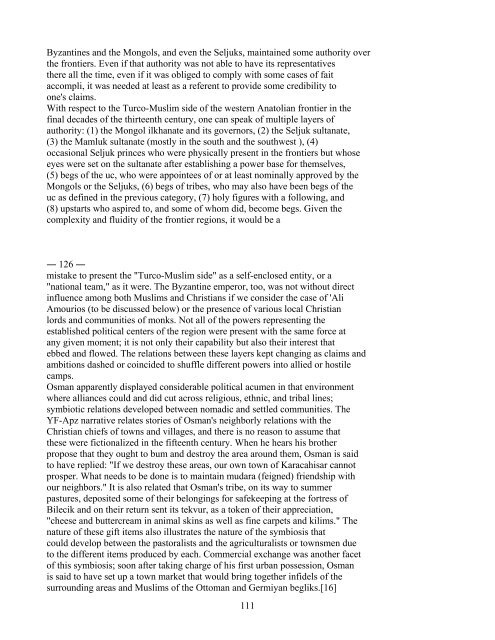Between Two Worlds Kafadar.pdf
Between Two Worlds Kafadar.pdf
Between Two Worlds Kafadar.pdf
You also want an ePaper? Increase the reach of your titles
YUMPU automatically turns print PDFs into web optimized ePapers that Google loves.
Byzantines and the Mongols, and even the Seljuks, maintained some authority over<br />
the frontiers. Even if that authority was not able to have its representatives<br />
there all the time, even if it was obliged to comply with some cases of fait<br />
accompli, it was needed at least as a referent to provide some credibility to<br />
one's claims.<br />
With respect to the Turco-Muslim side of the western Anatolian frontier in the<br />
final decades of the thirteenth century, one can speak of multiple layers of<br />
authority: (1) the Mongol ilkhanate and its governors, (2) the Seljuk sultanate,<br />
(3) the Mamluk sultanate (mostly in the south and the southwest ), (4)<br />
occasional Seljuk princes who were physically present in the frontiers but whose<br />
eyes were set on the sultanate after establishing a power base for themselves,<br />
(5) begs of the uc, who were appointees of or at least nominally approved by the<br />
Mongols or the Seljuks, (6) begs of tribes, who may also have been begs of the<br />
uc as defined in the previous category, (7) holy figures with a following, and<br />
(8) upstarts who aspired to, and some of whom did, become begs. Given the<br />
complexity and fluidity of the frontier regions, it would be a<br />
― 126 ―<br />
mistake to present the "Turco-Muslim side" as a self-enclosed entity, or a<br />
"national team," as it were. The Byzantine emperor, too, was not without direct<br />
influence among both Muslims and Christians if we consider the case of 'Ali<br />
Amourios (to be discussed below) or the presence of various local Christian<br />
lords and communities of monks. Not all of the powers representing the<br />
established political centers of the region were present with the same force at<br />
any given moment; it is not only their capability but also their interest that<br />
ebbed and flowed. The relations between these layers kept changing as claims and<br />
ambitions dashed or coincided to shuffle different powers into allied or hostile<br />
camps.<br />
Osman apparently displayed considerable political acumen in that environment<br />
where alliances could and did cut across religious, ethnic, and tribal lines;<br />
symbiotic relations developed between nomadic and settled communities. The<br />
YF-Apz narrative relates stories of Osman's neighborly relations with the<br />
Christian chiefs of towns and villages, and there is no reason to assume that<br />
these were fictionalized in the fifteenth century. When he hears his brother<br />
propose that they ought to bum and destroy the area around them, Osman is said<br />
to have replied: "If we destroy these areas, our own town of Karacahisar cannot<br />
prosper. What needs to be done is to maintain mudara (feigned) friendship with<br />
our neighbors." It is also related that Osman's tribe, on its way to summer<br />
pastures, deposited some of their belongings for safekeeping at the fortress of<br />
Bilecik and on their return sent its tekvur, as a token of their appreciation,<br />
"cheese and buttercream in animal skins as well as fine carpets and kilims." The<br />
nature of these gift items also illustrates the nature of the symbiosis that<br />
could develop between the pastoralists and the agriculturalists or townsmen due<br />
to the different items produced by each. Commercial exchange was another facet<br />
of this symbiosis; soon after taking charge of his first urban possession, Osman<br />
is said to have set up a town market that would bring together infidels of the<br />
surrounding areas and Muslims of the Ottoman and Germiyan begliks.[16]<br />
111













